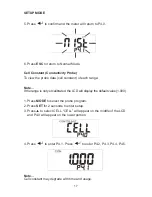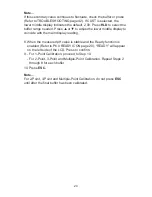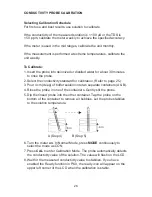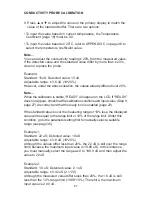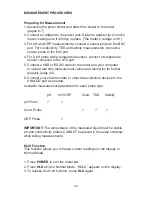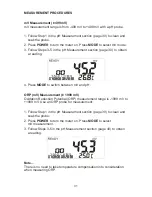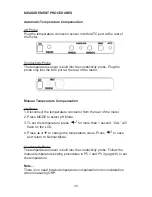
25
CONDUCTIVITY PROBE CALIBRATION
Selecting Calibration Standard Solution
For best results, select a conductivity, TDS or NaCl standard near the
sample value that you are measuring. Alternatively, use a calibration
solution value that is approximately 2/3 of the full scale of the
measurement range that you plan to utilize.
For example, in the 0 to 1999 uS range, use 1413 uS solution for calibration.
DO NOT reuse the calibration solution. Contaminants in the solution will
affect the calibration and the accuracy. Use fresh solution each time.
Refer to the table below. For best results, use the recommended solution
for various conductivity and TDS ranges.
The previous calibration data will be replaced after re-calibrating. For
example, if you previously calibrated the conductivity meter at 1413 uS
in the 0 to 1999 uS range, when you re-calibrate at 1500 uS again (also
in the 0 to 1999 range), the previous 1413 uS calibration point will be
replaced in this range (0 to 1999 uS). However, the meter will retain the
calibration data for other ranges that have not yet been calibrated.
Note…
The temperature coefficient of the meter defaults to 2.1% per °C and
provides good results for most applications. To reset the coefficient, see
P5.2 on page 18.
Conductivity
Measuring
Range
Recommended
Cal. Solution
Range
1
0 to 19.99 uS 6.00 to 17.00 uS
2
0 to 199.9 uS 60.0 to 170.0 uS
3
0 to 1999 uS 600 to 1700 uS
4
0 to 19.99 mS 6.00 to 17.00 mS
5
0 to 199.9 mS 60.0 to 170.0 mS
TDS Measuring
Range
(factor=0.5)
Recommended
Cal. Solution
Range
1
0.00 to 9.99 ppm 3.00 to 8.50 ppm
2
0.0 to 99.9 ppm 30.0 to 85.0 ppm
3
0 to 999 ppm
300 to 850 ppm
4
0.00 to 9.99 ppt 3.0 to 8.50 ppt
5
0.0 to 199.9 ppt 30.0 to 85.0 ppt







